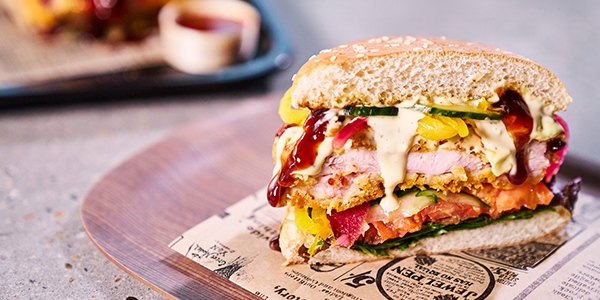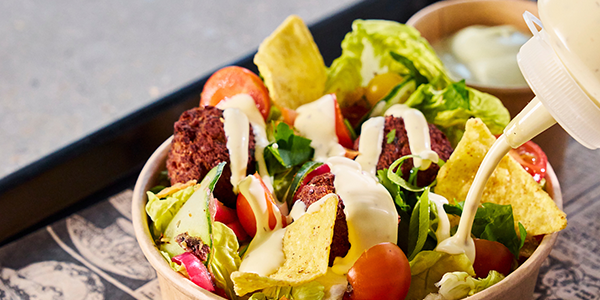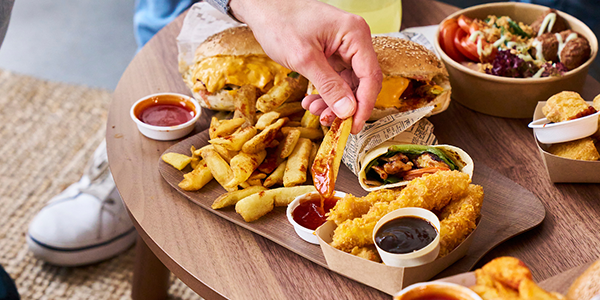Promotional Features
The secret to making incredible on-trend sauces
Maybe not the opening line you expected, but here is a hint for a first date: "What’s your favourite sauce?"
Whether someone is into salad dressings, dipping sauces, béarnaise, pesto, Mexican mole, gochujang, piri-piri or plain old mayonnaise, talking sauces is a good conversation starter. The fact is that we all love one sauce or another.
We’ve come a long way since the Romans used highly seasoned sauces to disguise spoiled food. Today, sauces have many other functions. Six, to be precise:
1. Sauces give food more flavour
2. Sauces give food a pleasant mouthfeel and texture
3. Sauces can be used to complement or contrast taste
4. Sauces make food succulent
5. Sauces give dishes an attractive appearance
6. Sauces add a sharp, tangy or creamy touch
This is not only the case for foods like pasta and chicken wings; it goes for countless dishes. In many of them, the sauce is the defining element across all six functions.
Sound like a whole lot of theory? Let’s get cooking.
Take a parmigiana dish or a schnitzel meal. Both focus on a protein, such as chicken or pork. However, it is the sauce that defines and differentiates the two meals. A creamy Jaeger sauce brings depth, richness and a delicious, mushroom-driven umami kick to a schnitzel, while a more acidic, Italian-style tomato sauce balances the melted cheese in a parmigiana. In both meals, the sauce checks off all its possible functions: flavour, texture, taste, moisture, appearance, and a distinct touch.
Sauce is crucial to steak, too. The bright acidity and colour of chimichurri, an oil-based sauce that is heavy on fresh herbs, illustrates how sauces enhance steak. The herbs enrich the protein, adding fresh, contrasting flavour notes, while the use of lime or vinegar cuts through the fat of the beef to balance the dish. Chimichurri also provides a splash of green, adding a great visual to a dish that otherwise consists of various shades of brown, making it more attractive to health-conscious consumers.
Dipping sauce, burger sauce, steak sauces or any other culinary sauce: they all have great sensory power.
The popularity of culinary sauces
According to 2022 consumer data, most people use cooking sauces at least once a month.1 North America leads the way, with one survey revealing 44% of adults in the US use cooking sauces several times a week.1
And Europeans? They’re not far behind. In France, Germany and the UK, the proportion of people that use cooking sauces every month ranges from 55% to 62%.2 Several studies indicate that these numbers won’t drop any time soon; UK sales of cooking sauces hit £879 million in 2022, and are forecast to grow at 9% CAGR to reach a value of £958 million by 2027.2
Why the growing popularity of culinary sauces?
First, the consumer appetite for new and exciting tastes. Ongoing globalisation brings the world to our homes and restaurants. Today, people can enjoy a wide variety of cooking sauces without having to leave their hometown: from Japanese miso all the way to Lebanese Toum – a delicious sauce so packed with garlic it can be a little spicy.
Second, because sauces speak to the senses like no other food product does. About 60% of consumers in North America and Europe use barbecue sauce, teriyaki, demi-glace and other cooking sauces to add flavour to their meals. Additionally, 48% say that they want to make the meal taste more interesting, while one in three consumers mainly rely on sauces to add juiciness.3
In another, heavily barbecue-focused survey of US adults, consumers said that they use sauces to add sweet, tangy, spicy and smoky flavours to their food.3
Third, sauces enable consumers to quickly, easily and affordably add key attributes to their foods. Half of US consumers prioritise lunches that are quick to prepare. Food costs, the desire for efficiency, and lack of skill all play right into the hands of sauce manufacturers.
Last but not least, the beauty of a sauce is that it can take the shape of anything that it’s put into, meaning each sauce can be tailored to the changing culinary landscape.
How sauces enable customisation
Sauces allow for deep personalisation; something many consumers are craving. In the simplest of terms, tailor-made sauce manufacturers can cater to multiple taste preferences without adding new products that could disrupt a manufacturing plant or food service kitchen. The core product line or menu can stay the same, but it can remain fresh and on trend using new, innovative sauces.
The same goes for chefs. With sauces, they can effectively tap into trends like healthy and plant-based diets. For example, 26% of people in the UK want more sauce options designed for vegetable-based main dishes.2
Meanwhile, many consumers explore different sauces to match personal preferences. A survey of more than 2,000 adults in the US found that 74% of Americans eat hot sauce with their food and almost half add hot sauce to their food at least once a week.4 The results also indicated an appetite for novelty, with 68% of those polled owning two or more brands of hot sauce, and 83% expressing a willingness to try new brands. In other words, more than four out of five people can still be won over by hot sauce manufacturers.4
Sandwiches and burgers provide further opportunities for customisation. Even the freshest buns possible can detract from the overall experience. Simply because buns can be dry, even when grilled, toasted or cooked for a minute or two.
Enter (semi-) liquid elements such as mustard, aioli and gravy. Take a roast beef sandwich, for example. Mustard balances the richness of the beef, while the fat in the aioli carries all the flavours, letting the gravy moisten the whole dish. This combination of ingredients and sauces creates an ideal balance of flavour and texture.
Quick service restaurants can bring new flavour profiles to their classic burgers using a creamy, acidic peppercorn sauce that complements the beef. Or use the acidity and heat of a buffalo sauce and the cooling, herbaceous notes of a ranch sauce with a coated chicken burger to bring balance by hitting all the taste buds with exactly the right amount of sweet, salt, spicy and sour notes.
Which consumer wishes shape sauces?
Taste alone doesn’t sell sauces. Today, food manufacturers need to be aware of different consumers’ drivers. Some trends stick, others don’t, and it’s up to each business to find their unique position in this constantly evolving playing field. But it all starts with being well-informed.
The demand that’s probably most prevalent among consumers today is health, referring not just to healthy salad dressings. Barbecue lovers, for example, express an explicit interest in better-for-you sauces, according to the aforementioned survey. Particularly sauces that are low in sugar and salt would score extra points for them.
The salt levels of sauces are a long-standing concern, which has led the UK Department of Health and Health Canada to set sodium targets. While the first results are promising in the UK, sauce companies can still differentiate themselves by further removing sodium from their products without compromising taste.5
The push for better-for-you sauces overlaps with an increasing demand for plant-based products. In 2020, a survey of European consumers indicated that 54% of people were already buying plant-based sauces and dressings.6 The headline result masked variation between countries, with consumption ranging from 34% in Germany to 72% in the Netherlands.6
Not surprisingly, the use of plant-based sauces varies between people who have eliminated or reduced their intake of animal products. While 58% have completely removed animal products from their diets turn to plant-based sauces and dressings, consumption among meat reducers is 40%.6
This suggests that there’s still a somewhat untapped market for products that closely match the taste, texture and price of animal-based equivalents. Indeed, as companies look to accelerate market share in new protein foods, plant-based sauces will be critical to achieve commercial success.
Partnering, the key to sauce innovation
The sauce industry is experiencing a huge transformation because of the change in customer needs and demand for healthier and natural options. Sauce makers are getting creative with their sauces, sometimes adding exotic herbs and spices, sometimes lowering the calorie level, sometimes integrating plant-based alternatives.
At the same time, there needs to be a focus on improving shelf life and convenience, all while keeping the price competitive. And those are just a few of the boxes to check.
Solina is a trusted partner for food manufacturers that works on the full spectrum of sweet and savoury foods, helping all types of food businesses to sauce up their dishes with flavour-packed and nutritionally enhanced liquid elements.
Through the acquisitions of sauce specialists Sauces et Créations and Atelier D2i in France, Zafron Foods in the UK, Saratoga Food Specialties in the US, and Lynch Foods in Canada, Solina has equipped itself to offer customised high-quality mayonnaise, condiments, dressings, marinades and any other sauce in many different types of packaging.
Solina’s sauce capabilities complement its culinary heritage, expertise in meat products, prepared meals, new protein food, vegetable applications, and history of supporting kitchens, enabling tailor-made ingredient solutions for clients in the food industry, foodservice, butchery and nutrition sectors.
Solina can advise and assist to take dishes to the next level in any business or industry.
Let’s find your secret sauce to success together.
References
1. YouGov. Trends in the global cooking sauce market.
2. Mintel. UK Cooking & Pasta Sauces Market Report - Market Size & Growth.
3. Brisan Group. 2020. Consumer Research: BBQ Insights.
4. Instacart. A Hot Take on America’s Favorite Hot Sauces.
5. Tan, M.; He, F. J.; Ding, J.; et al. (2019). Salt content of sauces in the UK and China: cross-sectional surveys. BMJ open, 9(9), e025623.
6. Proveg International. European Consumer Survey on Plant-Based Foods.






